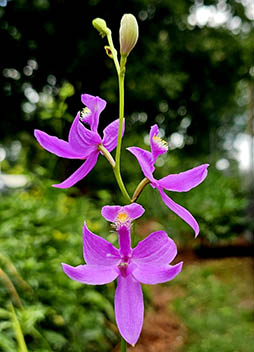Mother Nature’s Garden: Do your plants resupinate?
Published 10:28 am Saturday, July 6, 2024

- The bloom of the grass pink is not resupinate, so it looks quite different from the flowers of many other orchids.
|
Getting your Trinity Audio player ready...
|
Plants do amazing things. Vines can twine in either counterclockwise or clockwise directions. Our native wisteria twines counterclockwise, but Japanese wisteria twines clockwise. Some plants, such as Venus flytraps, pitcher plants, and sundews, can trap and consume insects. Others have blooms that can generate heat; they’re thermogenic. Still other plants, such as the boquila vine, in Chile, have the ability to take on the characteristics of the plant nearest to it. It can mimic the shape of leaves of other species. In fact, if it climbs on an artificial plant, the boquila even mimics the artificial leaves of its host. Boquila is a shapeshifter.
And then there are the plants that have resupinate flowers. As the flowers develop, they produce special hormones called auxins that initiate the process of resupination. The ovary twists, and the flower turns 180 degrees so that the top of the flower becomes the bottom. Many orchids have resupinate flowers. The lower lip is actually the top petal. By being at the bottom of the flower, it attracts pollinators and also serves as a landing pad for them.
So many orchids exhibit resupination that when we encounter one that doesn’t, the bloom looks quite strange. Our native grass pink (Calopogon tuberosus) has pink to magenta blooms that don’t resupinate, or twist 180 degrees, so the lip points upward when open. This position would seem to be a disadvantage, but the grass pink uses deception to attract bees and accomplish pollination. Long-tongued bees, such as bumblebees, leaf cutter bees, and carpenter bees, are attracted by the yellowish-orange hairs that mimic pollen on the lip. When the bee lands, its weight makes the hinged labellum swing downward, and forces the bee onto the column, thus transferring pollen from the bee to the stigma. When the bee leaves, it collects sticky pollen on the column and transfers it to another grass pink. The shape of the orchid flower seems strange to those of us so accustomed to seeing resupinate blooms, but it works perfectly for both the grass pink and its pollinators.
The grass pink can be quite difficult to find in the wild, but there are usually some in the bog garden at Lewis Ginter Botanical Garden. It’s not difficult to grow at home. Just add it to a pot of pitcher plants, and it’ll be quite happy there.
Dr. Cynthia Wood is a master gardener who writes two columns for The Herald. Her email address is cynthia.crewe23930@gmail.com.





